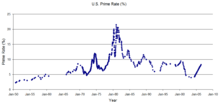U.S. prime rate
In general, the United States prime rate runs approximately 300 basis points (or 3 percent) above the federal funds rate. The Federal Open Market Committee (FOMC) meets eight times per year wherein they set a target for the federal funds rate. Other rates, including the prime rate, derive from this base rate.

When 23 out of 30 largest US banks change their prime rate, the WSJ prints a composite prime rate change.
Uses
The prime rate is used often as an index in calculating rate changes to adjustable rate mortgages (ARM) and other variable rate short term loans. It is used in the calculation of some private student loans. Many credit cards with variable interest rates have their rate specified as the prime rate (index) plus a fixed value commonly called the spread.